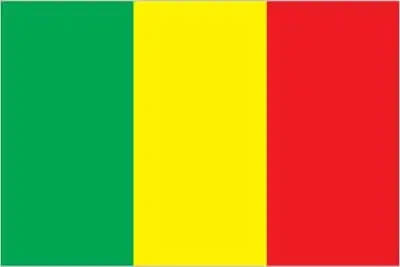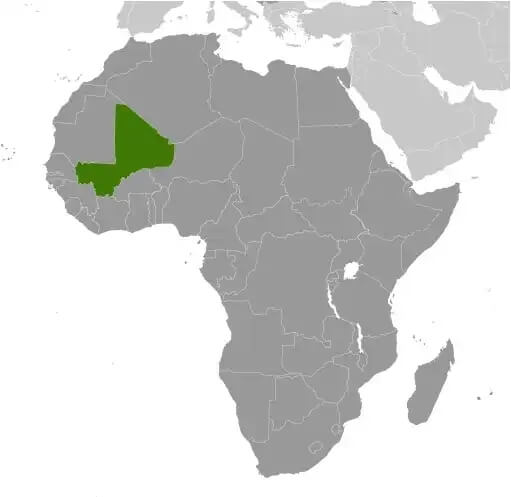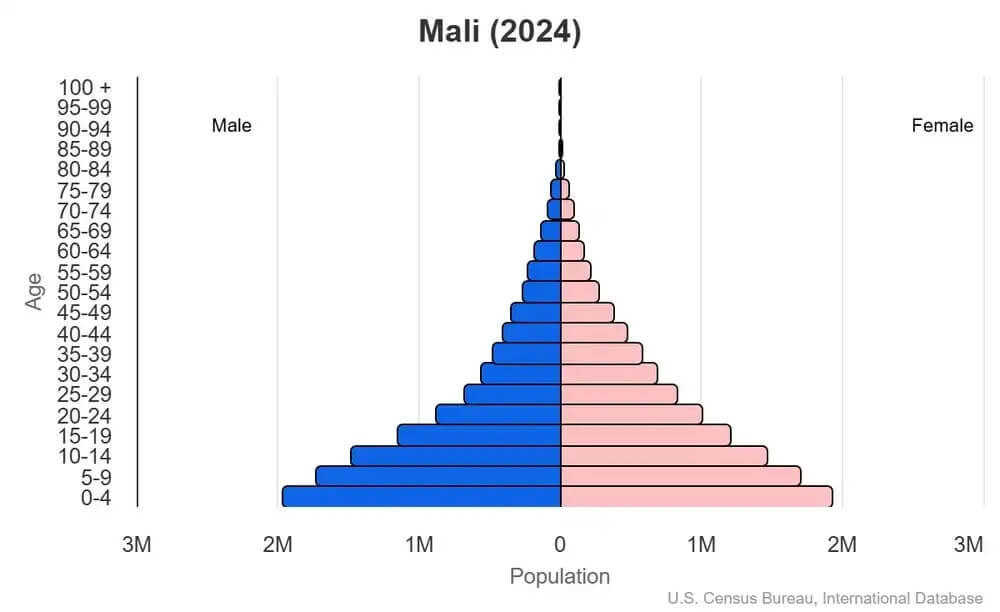World Book
Mali
World Book Index
41


With a score of 41, the country is ranked 152th out of 158 countries in the World Book ranking. (more information)
Introduction
Background
Mali is named for the Mali Empire that at its peak in the 14th century covered an area about twice the size of modern-day France. In the late 19th century, France seized control of Mali. The Sudanese Republic and Senegal became independent of France in 1960 as the Mali Federation. When Senegal withdrew after only a few months, the former Sudanese Republic was renamed Mali.
Geography
Area
total : 1,240,192 sq km
land: 1,220,190 sq km
water: 20,002 sq km
Climate
subtropical to arid; hot and dry (February to June); rainy, humid, and mild (June to November); cool and dry (November to February)
Natural resources
gold, phosphates, kaolin, salt, limestone, uranium, gypsum, granite, hydropower
People and Society
Population
total: 21,990,607 (2024 est.)
Ethnic groups
Bambara 33.3%, Fulani (Peuhl) 13.3%, Sarakole/Soninke/Marka 9.8%, Senufo/Manianka 9.6%, Malinke 8.8%, Dogon 8.7%, Sonrai 5.9%, Bobo 2.1%, Tuareg/Bella 1.7%, other Malian 6%, from members of Economic Community of West Africa 0.4%, other 0.3% (2018 est.)
Languages
Bambara (official), French 17.2%, Peuhl/Foulfoulbe/Fulani 9.4%, Dogon 7.2%, Maraka/Soninke 6.4%, Malinke 5.6%, Sonrhai/Djerma 5.6%, Minianka 4.3%, Tamacheq 3.5%, Senoufo 2.6%, Bobo 2.1%, other 6.3%, unspecified 0.7% (2009 est.)
Religions
Muslim 93.9%, Christian 2.8%, animist 0.7%, none 2.5% (2018 est.)
Population growth rate
2.9% (2024 est.)
Government
Government type
semi-presidential republic
Capital
name: Bamako
Executive branch
chief of state: Transition President Assimi GOITA (since 7 June 2021)
head of government: Transition Prime Minister Abdoulaye MAIGA (since 22 November 2024)
Diplomatic representation in the US
chief of mission: Ambassador Sékou BERTHE (since 16 September 2022)
Diplomatic representation from the US
chief of mission: Ambassador Rachna KORHONEN (since 16 March 2023)
Economy
Economic overview
low-income Saharan economy; recession due to COVID-19 and political instability; extreme poverty; environmentally fragile; high public debt; agricultural and gold exporter; terrorism and warfare are common
Real GDP (purchasing power parity)
$71.253 billion (2024 est.)
$67.857 billion (2023 est.)
$64.8 billion (2022 est.)
Real GDP per capita
$2,900 (2024 est.)
$2,900 (2023 est.)
$2,800 (2022 est.)
Exports
$6.13 billion (2023 est.)
$5.855 billion (2022 est.)
$5.381 billion (2021 est.)
Exports - partners
UAE 73%, Switzerland 15%, Australia 5%, China 1%, Uganda 1% (2023)
Exports - commodities
gold, cotton, oil seeds, fertilizers, gum resins (2023)
Imports
$8.066 billion (2023 est.)
$7.942 billion (2022 est.)
$7.596 billion (2021 est.)
Imports - partners
Cote d'Ivoire 25%, Senegal 19%, China 12%, France 5%, Burkina Faso 4% (2023)
Imports - commodities
refined petroleum, broadcasting equipment, cement, cotton fabric, plastic products (2023)
Human Development Index
The country's Human Development Index (HDI) is 0.419, ranking it 188th out of 193 countries tested. (more information)
World Happiness Report
The World Happiness Report ranked the country 135th out of 158 countries tested with a score of 4.054. (more information)



